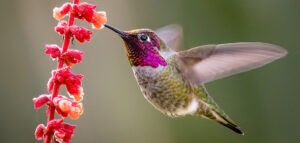Hummingbird density will fluctuate with migration and food availability
Hummingbirds are one of nature’s most fascinating creatures, known for their vibrant plumage and incredible flight abilities. However, during certain times of the year, these tiny birds seem to disappear from our gardens and feeders, leading to the common question: Where did the hummingbirds go?
Migration and the Seasonal Cycle:
Hummingbirds are migratory birds, meaning they travel great distances between breeding and wintering grounds. In North America, most species, particularly the Ruby-throated Hummingbird, migrate to Central America and Mexico when temperatures drop and food sources become scarce. They are highly attuned to the changing seasons and have evolved to follow a seasonal pattern to ensure they have enough food to survive.
Typically, migration begins in late summer or early fall when the days get shorter, temperatures cool down, and nectar-producing flowers begin to wane. Hummingbirds rely on an abundance of food sources to fuel their long journey. These sources mainly consist of nectar-rich flowers, insects, and tree sap. As these resources start to diminish, the hummers instinctively begin their migration south to areas where food is more abundant during the colder months.
Folks often ask, “Where are my hummingbirds? I had so many last year, and now I have only a few.” The explanation may surprise you, but generally all is well. Learn why.
The Need for High-Energy Fuel
Hummingbirds have one of the highest metabolism rates in the animal kingdom, requiring a constant supply of energy to maintain their flight. Their diet consists mainly of flower nectar, which provides sugars, and insects or spiders, which supply essential proteins and fats. Before embarking on their migration, they undergo a process called “hyperphagia,” where they consume large quantities of food to build up fat reserves. This fat acts as fuel for their long flights, which can be several hundred miles without stopping.
To prepare for this intense journey, hummers may feed on nectar from flowers, but they also visit bird feeders stocked with sugar water. Providing a reliable source of food in your backyard can make a big difference in helping them prepare for their trip.
The Mystery of Their Departure
As the days grow shorter, many people notice a decrease in the number of hummingbirds visiting their feeders. By late fall, they have likely  started their migration south. The exact timing of their departure varies based on factors such as the availability of food, the weather, and their individual readiness to migrate. Some hummers may leave as early as August, while others wait until October.
started their migration south. The exact timing of their departure varies based on factors such as the availability of food, the weather, and their individual readiness to migrate. Some hummers may leave as early as August, while others wait until October.
Once they head south, the hummingbirds travel along established migratory routes, often guided by innate instincts and environmental cues. While some may travel alone, others form loose groups known as “flocks” as they head to their destination. This migration can span thousands of miles, and these tiny birds are able to navigate using landmarks, the position of the sun, and even the Earth’s magnetic field.
Where Do the Hummingbirds Go?
Most North American hummingbirds travel to warmer climates, primarily in Central America and parts of Mexico. The Ruby-throated Hummingbird, for instance, flies non-stop across the Gulf of Mexico, a journey that can take up to 18 hours. Other species, like the Rufous Hummingbird, migrate along the western U.S. coast, reaching destinations in southern California and northern Mexico.
While these hummers are away, the landscapes they leave behind seem quiet, with fewer buzzing visits to feeders and flowers. However, this migration is essential for their survival, as it ensures they have access to the abundance of food available in warmer climates when the northern regions become inhospitable.
Return of the Hummingbirds
By early spring, as temperatures warm and flowers begin to bloom, the hummingbirds will return to their breeding grounds. This marks the end of their journey and the beginning of a new cycle. Many backyard enthusiasts are overjoyed to see their tiny visitors return after months of absence. The migration also coincides with the blooming of early spring flowers, which provide the necessary food to fuel their return journey.
Conclusion
Hummingbirds are remarkable travelers, following seasonal feeding patterns that are driven by their need for food and environmental cues. As the temperatures cool and food sources dwindle, they embark on their migration south to areas with more abundant nectar and insects. While their absence in winter might leave us wondering where they’ve gone, it’s a natural part of their seasonal cycle. As spring arrives, so too will these delicate and colorful birds, eager to resume their feeding and brighten our gardens once more.
To learn more about the mysteries and marvels of hummingbird migration click on the link.
To buy a book on hummingbird migration click on the link.


